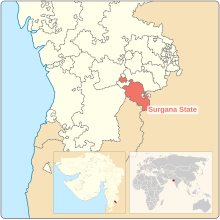Surgana State
| Surgana State | |||||||
|---|---|---|---|---|---|---|---|
| Princely State of British India | |||||||
| Late 18th century–1948 | |||||||
 Flag
 Coat of arms
| |||||||
 Surgana State in Nasik Agency during British India | |||||||
| Capital | Surgana | ||||||
| Demonym | |||||||
| Area | |||||||
• 1901 | 932.4 km2 (360.0 sq mi) | ||||||
| Population | |||||||
• 1901 | 11,532 | ||||||
• 1921 | 14,912 | ||||||
| History | |||||||
| Legislature | |||||||
• Upper house | Pawar | ||||||
| History | |||||||
• Established | Late 18th century | ||||||
• Independence of India | 1948 | ||||||
| |||||||
| Today part of | Maharashtra, India | ||||||
Surgana State was a princely state of the Bombay Presidency during the era of the British Raj.[1] It was the only state belonging to the Nasik Agency. Its capital was Surgana in Nashik District of present-day Maharashtra. It was ruled by Kolis of Pawar dynasty.[2]
Surgana State's last ruler signed the instrument of accession to join India in March 1948.
History[]
Surgana State was founded before the 1800s. Surgana State became a British protectorate in 1818.[3] The British made Bhikaji Rao as the new chief as he helped them against the Marathas. Bhikaji Rao was murdered in the riot caused by the mother of Malharrao and her brother-in-law, Pilaji. Pilaji was captured and executed by the British. The descendants of Malharrao were allowed the share in revenues of the state in 1846 and were granted an allowance grant in 1877. The chief of the state had powers to elect a Representative Member of the Chambers of Princes from 1921 to 1947. In March 1948, the last chief Dhairyashil Rao signed the Gujarat States Merger Agreement and ceded the state to India.
Later Dhairyashil Rao also served as the Member of the Rajya Sabha in 1952–1968 and 1972–1978.
The Princely State was bordered on the south by Peinth in Nasik, and in the west by the Bansda and Dharampur States.
Rulers[]
The rulers of the state bore the title deshmukh. Surgana State's rulers were said to belong to the .[4][5][6]
Deshmukhs[]
- bf.1800 – 1818 .....
- 1818 – 1819 Malhar Rao (d. 1819)
- 1819 – 1820 Bhikaji Rao
- 1820 – 1854 Jashwant Rao I Bhikaji Rao
- 1854 – 1867 Muvar Rao
- 1867 – 2 June 1898 Shankar Rao Ravi Rao (b. 1849 – d. ....)
- 1898 – 22 June 1930 Pratap Rao Shankar Rao (b. 18 August 1880 – d. 1930)
- 1930 – 1936 Jashwant Rao II Pratap Rao (b. 1902 – d. ....)
- April 1936 – 15 August 1947 Dhairyashil Rao Jashwant Rao (b. 1922 – 2003)[3]
See also[]
References[]
- ^ Chisholm, Hugh, ed. (1911). . Encyclopædia Britannica. 4 (11th ed.). Cambridge University Press. p. 186.
- ^ Nag, Sajal; Gurung, Tejimala; Choudhury, Abhijit (2007). Making of the Indian Union: Merger of Princely States and Excluded Areas. New Delhi, India: Akansha Publishing House. p. 356. ISBN 978-81-8370-110-5.CS1 maint: date and year (link)
- ^ a b Princely States of India
- ^ Lethbridge, Sir Roper (2005). The Golden Book of India: A Genealogical and Biographical Dictionary of the Ruling Princes, Chiefs, Nobles, and Other Personages, Titled Or Decorated of the Indian Empire. Aakar Books. ISBN 978-81-87879-54-1.
- ^ Pillai, S. Devadas (1976). Rajahs and Prajas: An Indian Princely State, Then and Now. New Delhi, India: Popular Prakashan. p. 4. ISBN 978-81-7154-057-0.CS1 maint: date and year (link)
- ^ Waghmare, Abhishek (14 April 2018). "Why Maharashtra farmers walked 170 km and how their strike played out". Business Standard India. Retrieved 5 September 2021.
- States and territories disestablished in 1948
- Nashik district
- Princely states of Maharashtra
- Rajputs
- Koli princely states
